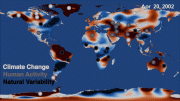

"Weather at the global level carries important information about climate," says Knutti.

The findings could have broad implications for climate science. The climate signal is thus prominent in the global values but obscured in the local values, since the distribution of daily mean values overlaps quite considerably in the two periods. If the distribution of global daily mean values from 1951 to 1980 are then compared with those from 2009 to 2018, the two distributions (bell curves) barely overlap. Whereas locally measured daily mean temperatures can fluctuate widely (even after the seasonal cycle is removed), global daily mean values show a very narrow range. By systematically evaluating the model simulations, they can identify the climate fingerprint in the global measurement data on any single day since spring 2012.Ī comparison of the variability of local and global daily mean temperatures shows why the global perspective is important. Statistical learning techniques can extract a "fingerprint" of climate change from the combination of temperatures of various regions and the ratio of expected warming and variability. In order to detect the climate signal in daily weather records, Sippel and his colleagues used statistical learning techniques to combine simulations with climate models and data from measuring stations. Statistical learning techniques extract climate change signature "Uncovering the climate change signal in daily weather conditions calls for a global perspective, not a regional one," says Sebastian Sippel, a postdoc working in Knutti's research group and lead author of a study recently published in Nature Climate Change. If it is simultaneously warmer than average in other regions, however, this deviation is almost completely eliminated. In plain English, this means that - despite global warming - there may well be a record low temperature in October in the US. According to the researchers, the climate signal - that is, the long-term warming trend - can actually be discerned in daily weather data, such as surface air temperature and humidity, provided that global spatial patterns are taken into account. The scientists concluded that the weather-is-not-climate paradigm is no longer applicable in that form. Now, however, a group led by ETH professor Reto Knutti has conducted a new analysis of temperature measurements and models. In short, the variability of local weather masks long-term trends in global climate. Climate is what we expect in the long term, whereas weather is what we get in the short term - and since local weather conditions are highly variable, it can be very cold in one location for a short time despite long-term global warming. Until now, climate researchers have responded that climate is not the same thing as weather. The previous low-temperature record for October was -35☌, and people wondered what had happened to climate change. In October this year, weather researchers in Utah measured the lowest temperature ever recorded in the month of October in the US (excluding Alaska): -37.1☌. 2, 2018: even if it is extremely cold in a region, this does not mean that climate change has stopped.

Image: North American surface temperatures for Dec.


 0 kommentar(er)
0 kommentar(er)
